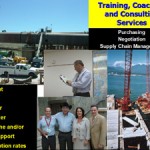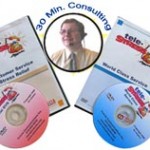
Robert Menard, Certified Purchasing Professional, Certified Professional Purchasing Consultant
Supply chain professionals liken purchasing to “Rodney Dangerfield, “I tell ya, we get no respect.” This Rodney Dangerfield affliction follows the purchasing profession to the field of software. Procurement software is a curious beast. The huge majority of software on the market is fundamentally aimed at enterprise applications. As such, purchasing, and the supply chain in general, is a neglected category, even though a cogent argument can be made that in business, purchasing is the tail that wags the profit dog.
In most enterprise wide applications, the purchasing capability tends to be an afterthought. Sales and accounting are the dominant forces in most enterprise wide software packages save for giants like Oracle, SAP, and others. The purchasing capability is usually an add-on module that is accounting based and feeble in purchasing capability. That is, it can typically generate RFx, POs, and interface with accounting but has poor capability in generating purchasing reports and spend analytics.
Market segmentation
It is not surprising that software has specialty niches just as do most other businesses disciplines. Enterprise wide packages are available for non-profits, educational institutions, manufacturers, professional service providers, hospitals, construction contractors and many other lines of business can find niche software suppliers customized to their industries.
With these software packages, purchasing capability tends to be minimum and routine. Requestors can go to the purchasing home page or portal to request goods and services. Given approvals and negotiated preferred supplier agreements in place, the request can even be converted to a PO and electronically transmitted to suppliers.
The notorious short fall of these products is almost always in spend management and analytics.
Spend management and analytics
The importance of these features cannot be over emphasized. Professional buyers must have the ability to create spend report at a click, not by dumping them manually into spread sheets. At a minimum, these reports include the following functionality.
Ability to sort and analyze spend by
- Part Number
- Variance report
- Supplier Name
- PO $ Amounts
- History
Capability for
- RFx creation
- PO creation
- Auto email for advice and approval
- P-Card, Ghost Card, and P/R card downloads
- Auto Data Capture (ADC)
- User friendly searchable data bases for suppliers, item number, keyword, supplier (drop down menus)
Additional features
- Web based login
- Inventory and consumables tracking
- Reoccurring order management
- Budget comparison and control
- Interface with A/P and enterprise software
- Pre-population of common fields with vendor data
- Add fields for T’s and C’s that are uploaded by auto text
Auto data capture (ADC) and electronic reporting such as
- Electronic Shipping Notice ESN)
- Electronic Receipt Notice
- Electronic upload to A/P after approval
IT Requirements check with IT first, then ask the supplier to specify
- Underlying technology such as cloud based, client server based, on premise installation or other
- Options such fixed fee with unlimited licenses, subscription based per user
- Integration with Lightweight Directory Application Protocol (LDAP) required
- Microsoft SQL server or compatible required
- Rental” rather than purchase of computing capacity and software
- Charges for trial period
- Site installation
- Support
Part Numbers (P/N) or Item Numbers
Part number terminology is a throw back to the manufacturing days of not so long ago wherein every part in an assembly (Bill of Materials) was assigned a unique identifying number. In much the same fashion that the typewriter keyboard is the basis for the computer keyboard, the same system still applies in the purchasing world but goes far beyond actual “parts”. Every purchase, whether tangibles such as furniture, food, computers, etc, and intangibles such as professional services, insurance (Workers Comp, CGL, life, health, etc), various forms of utilities (water, electricity, gas, oil, fire department charges, cable TV, etc), rent, leases, etc, is assigned a part or item number for the purpose of spend analysis.
Online demos
These are essential for qualifying or disqualifying potential suppliers. Insist on demonstration of every reporting feature. If the supplier is as experienced in purchasing as it represents, there will be a pre-populated data base with extensive information. The supplier should be able to demonstrate any report you choose. If the demo is weak, exclude the product. If it is strong, expect to be surprised with features you did not request like auto bid tabulation and supplier scored card native capability.
No matter how well the demo goes, insist on references and check the references. The best references will be those that simulate the size and type of organization you represent.

consulting services
Caveats for consultants
If you are an outside purchasing consultant, you have to repudiate the practice of consultant of some software suppliers that pay commissions and/or for recommendation of products and services. This practice is unethical, probably illegal, and must be scrupulously avoided.
In consulting capacities , I have had the good fortune to serve many clients and have learned this lesson; do not ask the client for their budget. This is not necessary and could taint the process. You could exclude higher or lower price range potential suppliers on the basis of price alone. The result may be that the Total Cost of Ownership of the particular supplier or product is recklessly excluded from consideration. You could also possibly tip your hand.
Because you are not the decision maker, you may face some understandable reluctance. Explain forthrightly that your job is a combination gate keeper and regulator; you qualify and disqualify suppliers based upon client demands and your expertise and experience. Unqualified candidates cannot get past the gate keeper and therefore do not need to speak to the end customer. The qualified prospects tend to understand, the others do not.
Lastly, do not engage in price negotiations at this stage. Suppliers are justifiably suspicious of the hired gun and will no doubt fear a price chop from the consultant before turning it over to the client for another whack. Focus on qualifying the prospect, the references, and most of al the capability. There will be time to negotiate later.










